If you have read our post, Driving in Costa Rica: What to Know Before You Go, you have probably picked up some tips for your upcoming trip. But how about driving in the rainy season specifically? In this post, we will explain what kinds of conditions you may encounter while driving during the rainy season. We will also give you some Costa Rica-specific info to make your trip as safe and stress-free as possible.

Background – When is Costa Rica’s Rainy Season?
Though it can vary by destination, the general rainy season in Costa Rica is from the month of May until early December.
Each month brings a different amount of rain. There are only a couple of months with very heavy rain.
The month of May typically starts off the rainy season with occasional showers and downpours. Not every day, though. The precipitation usually comes in the afternoon or at night. During the day, it can be very sunny and dry.
This pattern continues, with slightly more or less rain each month until mid-September. Early July, for example, often has a break in the rain. Of course, any month can have a big rain event mixed in.
By mid-September, heavier rain becomes more regular. This pattern lasts until early-November. Rain is still mostly in the afternoon and at night, but sometimes it can rain all day and for a few days in a row.
By late-November and early-December, it is usually back to intermittent rain, similar to the start of rainy season.
Mid-December through April is generally very dry, with only occasional rain.
Keep in mind that some parts of the country like the Caribbean coast follow a different pattern.
Read our post, Rainy Season in Costa Rica: How Wet Is It? It has more information on what to expect and gives typical weather patterns in each region.
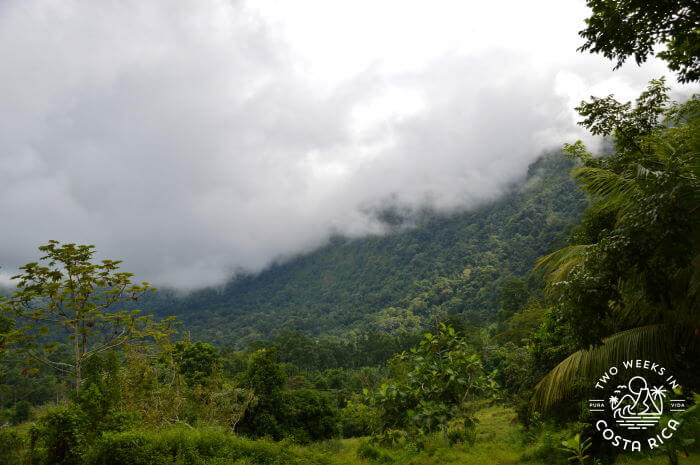
Driving During Rainy Season
For most of the rainy season, you don’t really need to change your driving plans. Costa Rica’s road infrastructure is designed to withstand a lot of rain. So, if a quick storm drops four inches (10 cm) of rain overnight, all that water likely will be drained away into rivers and streams before you hit the road in the morning.
Precautions for Driving During Costa Rica’s Rainy Season
Even though most rain events are easily handled by drains, gutters, and properly sloped roadways, there are some things to watch out for. Here are some tips and hazards to be aware of when driving in or after rainstorms in Costa Rica.
Driving at Night
We don’t usually recommend driving long distances at night in Costa Rica and especially urge against it during rainy season.
It already can be hard to see when you are driving Costa Rica’s roads at night. This can be for many different reasons. The lines getting faded from the sun (if there are lines), there being almost no streetlights in rural areas, a lack of reflectors, narrow shoulders, and few guardrails are just a handful of factors that can make visibility poor. To make it worse, if you add a sudden tropical downpour, it can be nearly impossible to see where you are going.
Your windshield wipers literally can’t keep up with the rainfall sometimes. Your windshield and mirrors also may get fogged up. This can make driving really stressful and slow.
If you keep the driving to daylight hours (5:00 a.m. to 6:00 p.m. in Costa Rica, year-round), you will avoid a lot of stress.
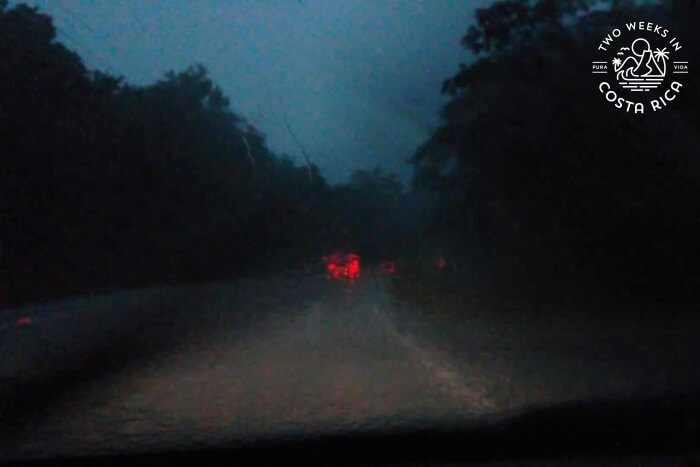
Landslides – Big and Small
Costa Rica has many elevation changes. Roads are often carved through rugged mountains with steep slopes above or below. When it rains hard, there can be landslides. Usually these are minor, with a bit of dirt or rocks falling into the roadway, possibly blocking a lane. A backhoe usually cleans them up within hours.
With bigger rain events though, large chunks of land can slide and cause major problems.
In our years living here, the biggest problem areas we have seen are on Route 2 between Cartago and San Isidro de El General and Route 32 to the Caribbean coast. Less frequently there are problems on Route 27 from San Jose to the Pacific coast. These bigger slides usually happen during historic rain events.

These events are rare, though. The average traveler will just encounter minor problems.
On your trip, watch out for mud, water, or small rocks that have washed into the road overnight from the entrances of steep dirt roads or driveways. These can be slippery or cause a sudden bump in the road you didn’t expect.
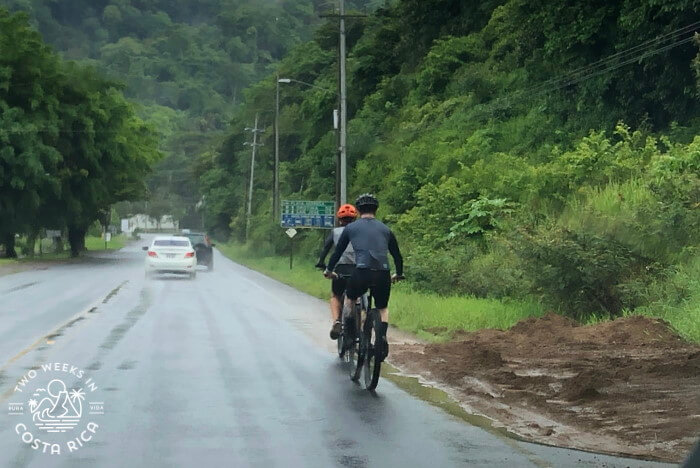
Shoulder and Road Washouts
Along the same line as landslides are shoulder washouts or washouts of an entire road. If the gutters along the roadside get clogged or can’t handle the volume of water, sometimes the edge of the road erodes away.
Usually, you won’t be the first to encounter these issues and someone will have put up some type of warning. At the edge of the hole or on either side, you may see caution tape, a big banana leaf laying in the road, or even a stick with a soda can on top marking the problem.
Occasionally, a larger part of the road is eroded away, but that is less common.
Use caution not to get too close to the edge of areas that have recently washed away. Again, obstacles like these are easier to see during the day, so another reason to avoid driving at night.
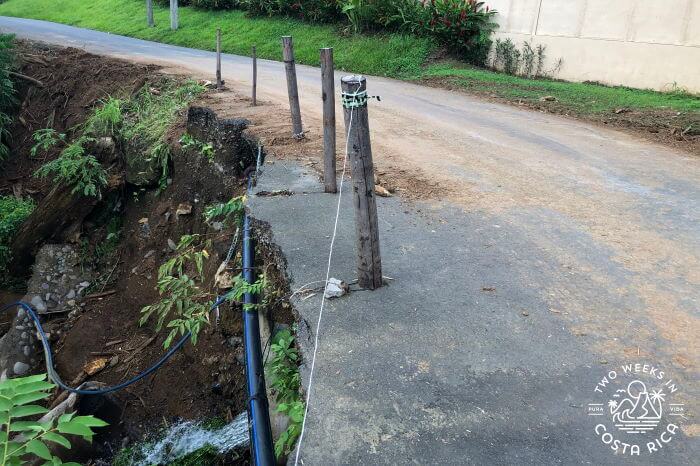
Down Trees
This is most common during the very rainy months like October and early November.
Since the soil along the roadside can get loose from all the water, occasionally trees fall into the road. Sometimes they are very big and require a machine to remove them. Road crews usually respond to these types of problems quickly so that the road can be reopened soon.
Water on the Road
A common problem we encounter when driving in the rain are areas of pooling. Sometimes it can just be a low spot in the pavement, or it may be a channel created by heavy truck tires. When water pools in these spots, it can cause you to hydroplane.
Small streams of water may also cross the road during or after a heavy rain. Though not usually deep, they can cause you to lose control if you hit them when driving fast.
Water on roadways is especially a problem when driving a rental car since they usually have more of a highway-type tire without a deep tread. Be sure to inspect the tires on your rental car to make sure they are not completely worn down. Some of the less reputable companies try to save money by keeping tires until they are basically unusable.
If you are looking for a rental car company that keeps up with maintenance (like tires), we recommend Adobe Rent a Car. Check out our discount page to save 10% and get free extras with them.
No matter what type of tires you have, always drive slower and more cautiously during or just after heavy rain.
Lowland Flooding
During the rainiest months and with big storms, sometimes entire roadways can be left underwater. This usually doesn’t last long but we have been delayed at times trying to get through somewhere or needed to find an alternative route.
If other cars the same size as yours are passing through a flooded roadway, follow their path exactly. Be careful not to drive through deep water as it could cause your engine to stall and damage to the car.

River Crossings
Even if there isn’t a lot of flooding, certain routes are best avoided during rainy season. Some back roads may go directly through creeks or shallow rivers. During the dry season, it is easy to cross these and the water is usually clear so you can see how deep it is.
But under rainy conditions, even the smallest creek can sweep a car away or cause it to stall. This can not only be dangerous, but this type of damage is not covered under your rental car insurance. So it is best to completely avoid river crossings.
Road Closures
If a big rain event has caused major damage to a road, it could be closed anywhere from a few hours for a small repair to a few weeks if major construction is needed. We have seen entire bridges get taken out by extreme rainfall in the rainiest months. This can take construction crews months of work. Big repairs like this are not the norm, though.
Most of the time a detour will allow you to go around these problems. However, sometimes that means going on some primitive back roads. These are usually dirt and sometimes go up and around the area affected. For this reason, we would recommend a 4×4 vehicle during rainy season if it is in your budget.
To find out ahead of time if there are any major closures, you can check the Transito (traffic police) website.
Tips for Rainy Season Driving
- Avoid driving at night.
- Be careful of puddling.
- Keep it slow and steady.
- Use your headlights when it’s raining.
- Use your hazards to warn cars behind you of pooling water or danger up ahead.
- Don’t attempt to cross streams or rivers.
- Watch for road hazards marked by makeshift objects.
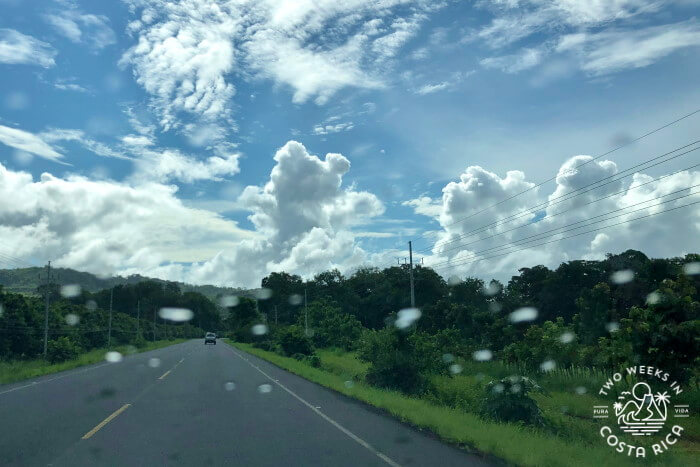
Conclusion
We hope that this post has helped you prepare for driving during Costa Rica’s rainy season. While there are things to watch out for, a little knowledge goes a long way. Rainy season is beautiful and a season not to be missed. We hope that you get the chance to visit, and your drive is smooth and uneventful.
Have a question or tip about driving during the rainy season? Leave a comment below.
Looking for more information to help you plan your trip? Check out these posts:
Renting a Car: Clearing Up the Confusion – This post answers common questions about renting a car and breaks down pricing. Mandatory insurance, extra fees, and things to be careful of when getting a quote.
Packing for Costa Rica: The Essentials – We always used to over pack before moving here. Check out this list for things that you may actually need and leave the rest behind.
Road Conditions of Specific Routes in Costa Rica – Are you a big planner? See this post for a detailed list of roads/routes and their conditions.
